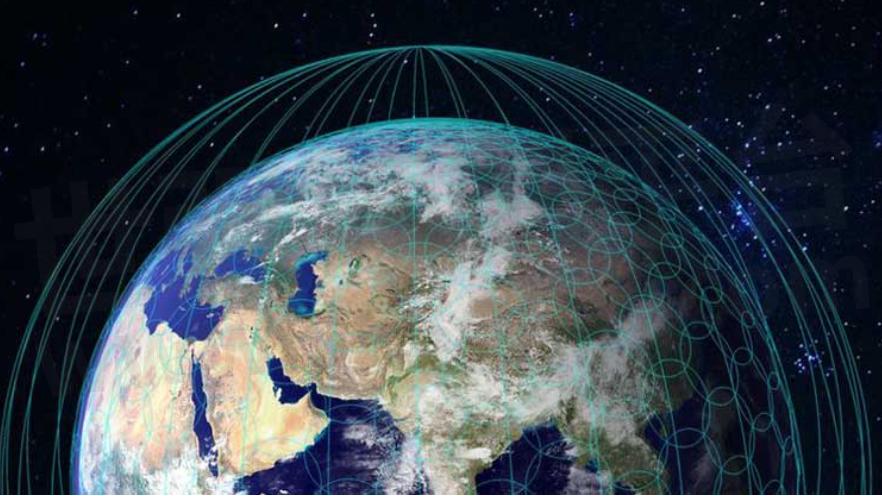The Internet of Space and Radiation Hardened Transceivers

We are on the verge of a new era of human connectivity and communications – the Internet of Space (IoS) is upon us. The explosion of worldwide communications over the past 25 years has led to the pervasive use of mobile and land communications equipment with an abundance of platforms, applications, and devices all driving the growth of many of the largest businesses in the world. There is no doubt that this trend will continue through the Internet of Things (IoT), along with improvements to the underlying network infrastructure. However, the next, ‘Small Step’ for man in terms of ubiquitous communications will be the ‘Giant Leap’ into the Internet of Space.
Internet of Space
The Internet of Space (IoS) is a long-term vision that leaders in some of the most technologically advanced companies in the world have begun to seriously consider. Both the European Space Agency and NASA have prepared plans that involve the deployment of networks of satellite around the Earth, Mars, and the Sun. These networks are composed of complex communications networks for MIMO microwave antenna arrays and free-space line-of-sight laser links.
These technologies will be responsible for the communications of manned missions to Mars and will have to have the best in terms of redundancy, speed, and network management as most of what we send up, will never be fixed. Further to this however, will be the machine-learning A.I. systems on-board exploratory robots and landers for the moon and Mars including asteroid mining that will be tasked with resource extraction. For example, before the arrival of astronauts on Mars, dozens of intelligent, self-exploring robots and rovers will have to have found water on the planet for them. The self-driving cars of today will become the self-exploring robots of space.
New players in space exploration

Fig.1
Coverage areas of each of OneWeb's planned satellites. (OneWeb)
The success of companies like SpaceX has shown that many of the traditionally held ideas about space exploration are breaking down and commercial opportunities are starting to be explored.
With more reliable, lower-consumption, smaller, and more powerful computer systems, it is now possible to truly envision complex space networks.
OneWeb Satellites is planning the launch 900 satellites into low Earth orbit beginning in 2018, to deliver Internet access globally.
TeleSat, a Canadian company, has the plan to deploy almost 300 LEO satellites by 2021 to serve as an interconnect for continual 3G data networks for ship and aircraft connections over the oceans. However, as more commercial-off-the-shelf (COTS) parts are targeted for space applications as a means to take advantage of powerful technologies at lower costs, a more meaningful business-case for vendors can now be made to support the space-vendor-ecosystem.
Space environment
However, there is a catch… The space environment itself is extremely severe; outside the protective cushion of the earth’s magnetosphere, exposure to radiation and extreme temperatures can destroy terrestrial electronics. Therefore, to open these markets, the vendors will have to meet the space community half-way, and do what they can to “space-ify” their COTS products.

Fig.2
SpaceABLE is available in different configurations: 50G (4 TX plus 4 RX lane per device) and 150G (12 TX or 12 RX lane per device).
Reflex Photonics technology brand has a plan to do just that – with the cost of sending even just 1 kg into space at over $ 50k, the advantages of using the Reflex Photonics’ line of small, lightweight, high-density SpaceABLE™ parallel optical transceiver modules inside the satellites will impact this enormously.
The Reflex family of SpaceABLE modules offer extremely high aggregate data rates (over 150 Gbps), the modules are less than 3 cm2 and weigh less than 5 g. They can be placed anywhere on a motherboard or linecard linking powerful CPUs, GPUs, and FPGAs across multiple boards and racks.
Rigorous testing
In terms of reliability, the SpaceABLE product follows the rigorous environmental testing of MIL-STD-883 with a variety of thermal shock, vibration, humidity, and cycling tests included. Furthermore, Reflex Photonics has qualified these parts under very stringent radiation exposure tests: Active Heavy-Ion testing for latch-up, SEE and SET failures, long-term irradiation from PIF and NIF cyclotrons, and long-term exposure (over several weeks) of gamma-rays using Cobalt-60 on active parts. These tests were all done concerning the ECSS-Q-ST-60-15 Space product assurance standard - Radiation hardness assurance - EEE components.
The space community is slowly evolving from an era of mega-projects and unlimited budgets to a dynamic industry that envisions a commercial market with volumes that can support multiple businesses. It can no longer afford the “nine-nines” of reliability – especially when private commercial enterprises like Virgin Galactic’s SpaceShipOne and XCOR’s Lynx space vehicles are rapidly closing in on traditional institutional domains. Reflex Photonics is part of this belief and this ultimate goal of Bringing space a little closer™ by offering optical transceivers and optical infrastructure that will enable the next generation of space exploration.
- +1 Like
- Add to Favorites
Recommend
- Smiths Interconnect Announced the Expansion of Space-qualified Products Used in LEO Constellations
- Exploring the Cutting-Edge SpaceABLE® Radiation-Resistant Embedded Optical Transceivers from Smiths Interconnect
- Smiths Interconnect SpaceABLE® Radiation-resistant Optical Transceivers at the Heart of SES-17 Satellite
- Smiths Interconnect Offered Isolators to Support NASA’s Europa Clipper Mission to Explore Jupiter’s Moon
- Revolutionizing Space Component Engineering: Smiths Interconnect‘s Space Qualification and Rapid Engineering Laboratory
- Smiths Interconnect Launches Space Qualified Version of KVPX Connector Series
- Spaceable Modules Offer High Aggregate Data Rates to The Internet of Space And Radiation Resistant Transceivers
- Smiths Interconnect SpaceNXT Series: Elevating Space Connectivity with Pre-Tested & Qualified Interconnects
This document is provided by Sekorm Platform for VIP exclusive service. The copyright is owned by Sekorm. Without authorization, any medias, websites or individual are not allowed to reprint. When authorizing the reprint, the link of www.sekorm.com must be indicated.





























































































































































































































































































































































































































































































































































































































































































































































































































































































